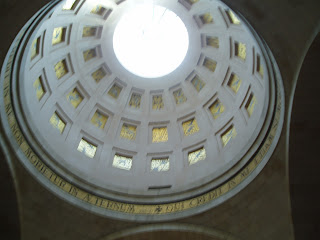On August 11, after we moved form Jerusalem to the Casa Nova in Bethlehem, we started off the day by having mass at the Basilica of Bethany. The Basilica is built close to the spot of the Tomb of Lazarus, where Jesus resurrected him from the dead in Jn 11:1-46. Secondly, it is also ascribed to be where the house of Martha and Mary, Lazarus' two sisters, are located and which Jesus visited in Lk 10:38-42. Thirdly, it is also the location where Jesus begins his triumphal procession into Jerusalem on Palm Sunday (Mk. 11:1; Lk:19:29) as well as the place where Jesus stayed during Holy Week leading up to His passion (Mt. 21:17; Mk. 11:11-12). Finally, it is also noted as the place where the house of Simon the Leper was located where Mary anoints Jesus (Mt. 26:6-13; Mk. 14:3-9; Jn 12:1-8). The Basilica at Bethany was designed by the Italian Architect Antonio Barlutzzi and is under the custody of the Franciscans of the Holy Land.
 |
| Fabritzio explaining the Basilica |
 |
| Fr. Fabian Lopez celebrating Mass |
 |
| A Plaque commemorating Pope Paul VI visiting the Basilica during his visit to the Holy Land in 1964 |
After visiting the Basilica, we proceeded to visit the Fortress of Masada which overlooks the Dead Sea. It was built by King Herod the Great in 37 and 31 BC as a place where he could flee from possible revolts against his authority. In 66 AD, Jewish rebels known as the Sicarii seized control of the fortress and used it as a place from which they could lead raids against the Romans. The Romans under the command of Lucius Flavius Silva started to the fortress between 72 and 73AD by building a siege ramp. The Romans finally breached the walls on April 16, 73AD and found that the 960 remaining Jewish rebels all committed mass suicide. It is a major tourist attraction and symbol of Israeli Patriotism.
 |
| The Mountaintop of Masada |
 |
| A Model of the Original Fortress |
 |
| A Cable Car going to the top of the mountain |
 |
| Fabritzio explaining the history of the siege to us |
 |
| Ruins of the Roman Siege Ramp |
 |
| Ruins of the Roman Camps |
 |
| Ruins of the Columbarian Tower where messenger doves were kept |
 |
| Ruins of Roman Style Baths |
Afterward we spent the remainder of the day swimming in the Dead Sea



























































